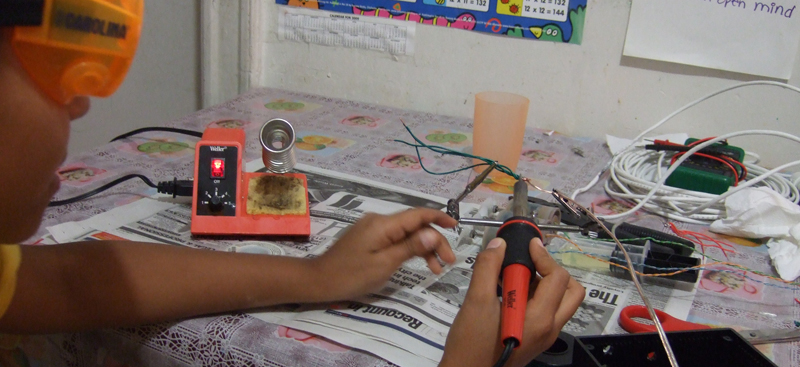Last summer a small class of high school students learned Python coding, neuroscience and statistics to develop their own brain imaging experiment using electroencephalography (EEG) and analyze the data. Most science and technology classes of this level of acuity would attract students from families that could pay.
But not this class—it was free, and made up entirely of Latino students or newly arrived immigrants, with one student arriving in the US less than two years earlier. And it was taught from an outdoor food court in an industrial complex in Brooklyn.
We run Sunset Spark, a hyperlocal non-profit that teaches high quality science classes around our neighborhood through what we call “noloco”—short for no location—hackerspaces, to help immigrant families be tech leaders. While many STEM outreach organizations focus on scaling wide across the nation and world, we focus on scaling deep so that every family in our neighborhood, a working class and immigrant neighborhood in Brooklyn, has consistent access to high quality science and technology classes. The entire neighborhood is our classroom. The food court is not the only unorthodox venue; we also teach workshops in a cemetery.
One way or another, the families we serve are shut out of STEM opportunities available in maker- and hackerspaces, meetups and selective private schools. Chalk it up to meritocracy, culture clash, social capital, financial resources; the reason isn’t as important as the undeniable result: underrepresented groups continually find themselves without access to high quality science and technology classes. Here in New York, there are plenty of after-school programs and summer camps for game design, Lego robotics, or Minecraft modding. But their costs are prohibitive—and many don’t offer instruction in languages other than English.

Wisking kids off to coding programs is great for access, but not for culture. What happens when the student leaves the coding workshop and the hour long commute back to their “bad” neighborhood?
Low-income kids should not need to leave their neighborhoods to get continued access to high quality technology classes. From our vantage point, the movement will never make a meaningful impact in working class communities—no matter how many Hours of Code, scholarships or workshops—until the learning, experimenting, and building happens in their neighborhood and community. This can and should come in many forms: formally in traditional classrooms, informally through local clubs, and most importantly at home. Students of all ages need peers, collaborators and mentors within reach to build their own community and define their own culture around STEM.
Involving the whole family—kids, parents, grandparents—amplifies impact; one positive relationship with science and technology can lead to a whole family of hackers. One of the ways we get parents involved is by holding classes in their homes, which lets us see their technology situation. More often than not, they have a home computer in some state of disrepair. We help fix up any computers they might have and set up development environment for classes we teach, like Brackets, Processing, Arduino, Lego Mindstorms, or CAD software.
You wouldn’t realize it looking at the landscape of coding classes, but not everyone wants to make a web app. Digital natives want to make websites about as much as digital immigrants want to write a book. In our general-ed coding class at the local high school, students learn Processing to create generative and glitch art. We look at subjects that kids and parents are into, like art, dance, or caregiving, and design classes around those interests that incorporate modern STEM skills like coding, soft circuitry, and 3D printing.
Last summer we started the Green-Wood Inventor’s Club, which combines history and technology to create short workshops for visitors at the Green-Wood Cemetery, a national historic cemetery that also serves as the biggest greenspace in our neighborhood. Each workshop covers the history behind a famous inventor or designer with a hands-on project at the chapel and their burial site, introducing new technology in the vein of their work. For example, for the Tiffany family, we covered their famous stain glass and jewelry, then had visitors design their own rings and bracelets to print out right there on the spot. Another workshop covered Elias Howe and Isaac Singer, feuding sewing machine inventors, and sewable circuits in embroidery hoops.

In another class, we focus on the caregiving aspect of immigrant households. We teach parents of kids aged two through five about mathematical thinking and how to use CAD software and 3D printers to develop their own toys and encourage mathematical development in their children. This class is taught out of apartments, both our own and the parents. Small as their apartments may be, many of their homes are already set up like tiny classrooms, complete with easel boards, alphabet strewn walls, and toys for creative play.
All of our classes are led by us personally. For our Lego robotics program, we have a dedicated mix of volunteers through New York Cares as well as parents we trained. Though we are largely unfunded, the biggest cost outside of time is materials. The schools we work with, along with New York Cares, and small grants from NASA and Columbia University, have helped us purchase expensive items like robotics kits and 3D printers. Less expensive materials like Arduinos and sensors come out of our own pocket until we are fully funded.
The benefits of our community-driven approach are already showing. Every week we receive a call from a parent looking for a class for their kid or strike up conversation with a stranger in the neighborhood about technology. Our programs have scaled to eight schools and a variety of public spaces in the neighborhood; this summer we will have classes at laundromats, a subway station, and a new waterfront park. Our purpose is to saturate the neighborhood with high-tech classes so that everywhere a family goes they will have the opportunity to learn new technology.


